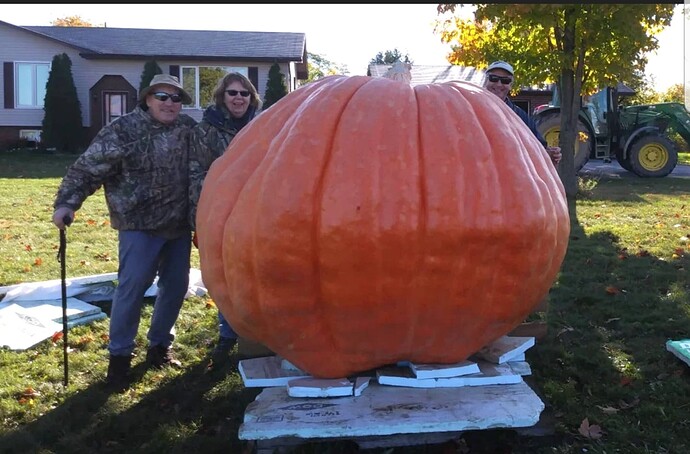Now I’ve spend half the morning reading through the whole thread. ![]()
And Footrot Flat reminds me of when I hitch-hiked through NZ in the 80s.
So I like to show this comic
https://www.footrotflats.com/strip-archive?strip=56
https://www.inaturalist.org/taxa/418699-Macropathinae
and can’t find the one I remember about catching flounders by stepping on them - but then it was a stingray. I must have my books still somewhere.
(I moved this discussion to its own topic)
The right hand side of that curve is completely wrong… it should flatline :D
Edit: wait. I’m not willing to talk about it
What part of the curve is that based on?
It’s a petty peeve for me, this obsession for North American mega produce. Blueberries the size of what I think strawberries should be, and strawberries the size of what plums should be. And… so on.
The one thing that seems to hold true is that the bigger they grow them, the more tasteless they become.
Big sells well here, but not most places. I worked at a college in Canada here, and one year the International Dept. did some interviewing with international students about what they found most difficult about adjusting to life here and presented it to staff as a series of recorded interviews.
What struck me was the message from several Asian students about being freaked out by our giant, tasteless groceries.
By the way, I’ve heard that technically, the largest berry in the world is one of these:
That sounds about right. Compared to Europe, everything in America is bigger from the parking lots and parking spaces to accommodate bigger cars to the stores to the huge grocery carts to whatever produce is offered to put into those carts… That’s certainly one big berry there.
Common usage of the words compared to botanical usage is one of the trickiest things our students struggle with. Here’s a fun one for botany quizzes: Which of these fruits is a berry? (Hint: Only one of them fits the botanical definition).
A) Strawberry
B) Blueberry
C) Raspberry
D) Mulberry
E) Blackberry
Similarly, which if these is a true nut? (Again, only one fits the botanical definition.)
A) Walnut
B) Peanut
C) Coconut
D) Hazelnut
E) Pine nut
American Exceptionalism: Quantity, not quality!
where do cashew nuts fit in?
Cashews are fun! The “nut” is the seed of the cashew apple, an accessory fruit.
It seems risky to leave the seed so exposed. Don’t they get eaten before they can hope to grow into plants?
Let’s see if I remember this…
B) blueberries are the real berries.
In strawberries the red part is a receptacle, with the small yellowish “seeds” being the actual fruits, as they’re each an achene (similar to a sunflower seed).
Blackberries and raspberries are aggregates of druplets (a druplet is just an especially small drupe. Remember before that I said a drupe is a fleshy fruit with one seed that formed from one ovule, such as a peach. Blackberries just have flowers with multiple ovules so they end up with multiple little drupes in a clump.)
Mulberries I didn’t learn about specifically, but I’m guessing they’re also multiple fruits stuck together, probably the catkin is in fact a string of many small flowers and thus turns into a clump of small fruits.
A) walnut
Peanuts are actually more like peas, not nuts, being a member of the legume family, as beans and peas are.
Coconuts, Wikipedia tells me are a drupe, which I didn’t know. The only thing I remember learning about coconuts in school was something weird about their fertilization, maybe the male gametes in coconut pollen actually fertilize multiple female gamete cells and they’re in there together in the coconut (?)
Hazelnuts, I probably would have thought they were real nuts if I weren’t so sure the answer was A. I have no idea what they look like on the tree.
Pine nuts clearly can’t be nuts because nuts are a type of fruit, and gymnosperms don’t make fruit. That’s kind of their definition!
Peas and beans are seeds in a pod, while peanuts are below ground energy reserves (tubers?)
Isn’t a peanut shell a pod? And peanuts have embyonic plant structures, like a bean, indicating they are seeds, no?
I was mistaken!
Peanut fruits develop underground, an unusual feature known as geocarpy.[17]After fertilization, a short stalk at the base of the ovary — often termed a gynophore, but which actually appears to be part of the ovary — elongates to form a thread-like structure known as a “peg”. This peg grows down into the soil, allowing the fruit to develop underground.[17]
Walnuts are drupes, actually. The “nut” is the stone inside a fleshy husk, similar to a cherry pit. The husk is what walnut dye/ink is made from and it’s quite colorfast, so removing it with a hole in your gloves leaves you with an orange-brown dyed finger until the skin cells get around to sloughing off and being replaced. Ask me how I know… ;-)
Peanuts are legumes with the weird habit of putting their fruits underground. The shell is the pericarp (fruit wall), the papery brown husk is the seed coat, and what we eat that splits into two halves is actually the embryo with two cotyledons.
What does that mean the answer is hazelnut? Ha! I have seen walnuts on the tree and I knew about the husk but I was still fooled.
That’s what I said.
“ Isn’t a peanut shell a pod? And peanuts have embyonic plant structures, like a bean, indicating they are seeds, no?”
Yes, that’s the one. :-)
And yes, peanuts are essentially like bean or pea pods.
I’m not even sure what the topic was???
Tony moved us from the “nature inspired comics” thread
